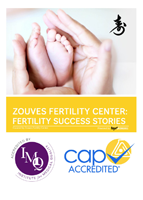At Zouves Fertility Center through PGT-A and IVF with Delayed Transfer we are able to identify one normal embryo for transfer and improve your chance of pregnancy and decrease your chance of miscarriage.
We maintain our commitment of nondiscrimination based on age, marital status and sexual orientation. We continue to treat patients for whom IVF is medically indicated, even if their chance of success may be less than age-matched controls. Zouves Fertility Center is committed to tailoring our care to individual patient needs.
Clinics are required by law to report their annual in vitro fertilization (IVF) cycles and subsequent pregnancies to the Center for Disease Control (CDC). These figures are published each year, two years after the cycles were initiated because live births must be recorded. Therefore, for example, the cycle data for 2015 was published in 2017.
A full list of pregnancy and live birth rates from centers across the country can be viewed at the nccd.cdc.gov. When on the site select Detailed Data Summary for a complete view of our statistics. This data is also published at www.sartcorsonline.com.
NOTE: A comparison of clinic success rates may not be meaningful due to patient medical characteristics, treatment approaches, and entrance criteria that may vary from clinic to clinic. At Zouves Fertility Center we preferentially perform PGT-A (preimplantation genetic testing-aneuploidy) elective single embryo transfer (eSET); please use the filter options in the top right of the website to select an option that best suites your treatment plan.
To further assist you in understanding the chance of success in our program, all embryos are scored for quality at the time of transfer. The best embryos are AA and the poorest embryos are CC. The quality of the embryos you create will greatly influence your outcome.
Embryo Scoring
Day 5, 6 and 7, blastocyst stage embryos are composed primarily of two cell types; the inner cell mass and the trophectoderm. The inner cell mass gives rise to the baby and the trophectoderm gives rise to the placenta. The first letter of the grading system refers to the inner cell mass (ICM) and the second letter refers to the trophectoderm. The ICM is graded on the number of cells and the degree of cellular compaction. Similarly the trophectoderm is graded on the number and cohesion of cells making up an epithelium. For example an AA embryo contains many tightly compacted ICM cells and many cohesive trophectoderm cells.
The table below shows the implantation rate of each euploid (normal) embryo used for eSET across all age categories in 2017 at Zouves Fertility Center.
Implantation frequency of all embryos used for PGT-A eSET in 2017
| A | B | C | |
|---|---|---|---|
| A | 84% (21/25) |
60% (18/30) |
(1/1) |
| B | 56% (10/18) |
55% (77/140) |
41% (13/32) |
| C | (1/2) | (4/13) | (2/10) |






